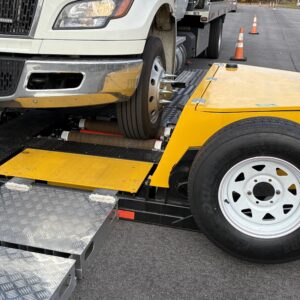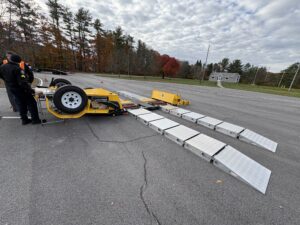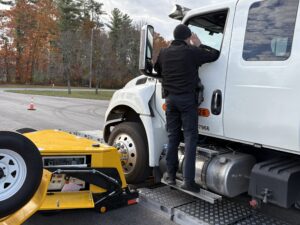The Maine State Police have introduced a new Performance-Based Brake Tester (PBBT) that is being transported to weigh stations across the state, to assess the braking performance of commercial motor vehicles (CMV’s). This device aims to ensure that commercial trucks and trailers meet required safety standards for braking force outlined in section 393.52 of the FMCSA Safety Handbook. Recently, Maine Motor Transport Association visited the York Weigh Station to observe the PBBT in action.
How the PBBT System Works
The PBBT is a drive-on platform that keeps vehicles level during testing. The system includes a single axle roller-dyno, so it assesses each axle individually as the device spins. Here’s how the process unfolds:
- Positioning: Drivers are guided onto the platform until the first axle aligns with the rotating testing area.
- Testing: Drivers shift the vehicle into neutral, and the PBBT rotates the wheels at speeds of about 3–6 mph.
- Braking: When prompted, drivers steadily apply a gradual increase in braking pressure over a 4 second span. At the end of the 4 seconds the driver will hold the brake until prompted to stop. We noted smaller CMV’s may shift during the brake process, this is a controlled movement and is a natural part of the evaluation.
The PBBT measures each wheel’s brake force individually and calculates braking efficiency based on the vehicle and trailer’s weight. After each axle is evaluated, the PBBT produces a computer-generated “Pass” or “Fail” determination based on the total results of the vehicle and trailer. FMCSA guidelines break down the braking force as a percentage of gross vehicle or weight combination, on a chart found here. The entire sequence from start to finish, generally takes about 5-10 minutes, and the attending Trooper or Inspector provides step by step instruction throughout the entire process.
Upon completion of the PBBT evaluation, drivers are verbally notified of their brake force pass or fail. As the PBBT is only a screening tool, CMV’S that pass the evaluation will not be given a clean roadside inspection report. Those that fail are given a printed result of each wheel’s braking results. Violations are not written solely upon the PBBT failure, however, the CMV will undergo a level 1 inspection to determine the cause of the failure and the driver will be issued a roadside inspection report. In the unlikely situation where the cause of the failure is unable to be determined, the driver will be given a roadside inspection list of items to be inspected by an appropriate service technician before the CMV may operate again.
Importance of PBBT Testing
According to a brochure from the Commercial Vehicle Safety Alliance (CVSA), the PBBT system offers numerous advantages that go beyond visual inspection capabilities:
- Safety and Performance: Assesses brake force output and balance, which impact stopping distance.
- Benchmarking: Checks brakes on new or newly installed systems to establish a maintenance baseline.
- Liability Limitation: Ensures vehicles leased/rented by equipment providers have adequate braking power.
- Air System Issues: Detects problems in the air system, such as an early apply threshold.
- Drum/Rotor Irregularities: Identifies issues with drums and rotors that affect brake performance.
- Parking Brake Inspection: Highlights broken or weak spring brakes.
- Brake Balance: Ensures each wheel’s braking force is proportional, reducing wear on other brakes.
- Axle Weights: Provides axle-weighing capabilities, though not a substitute for a certified scale.
- Increased Throughput: Expedites brake checks, offering peace of mind for fleet operators.
- Fuel Efficiency: Reduces fuel consumption by identifying dragging brakes or bad bearings.
For more detailed information on the benefits and specifications of the PBBT system, you can view the CVSA’s brochure.
Commercial Vehicle Safety Alliance. (n.d.). Performance-based brake testing: A guide for enforcement and industry. https://www.cvsa.org/wp-content/uploads/PBBT_Brochure.pdf
We would like to thank Troop K of the Maine State Police for teaching us about their new tool and for their continued efforts to keep Maine’s roads safe! For more information on the PBBT system, check out the video here. As always, feel free to contact Randy or Tim at MMTA for more information.



